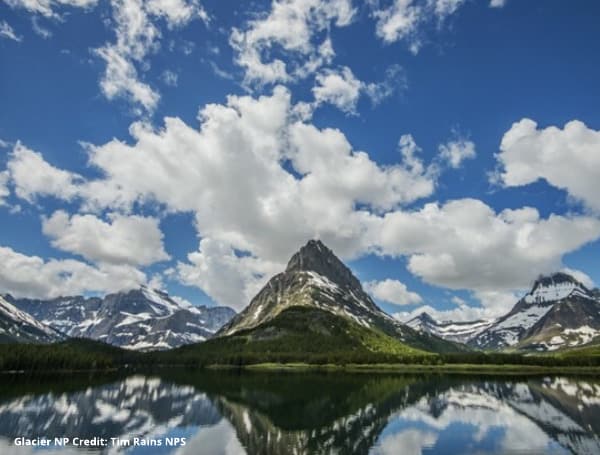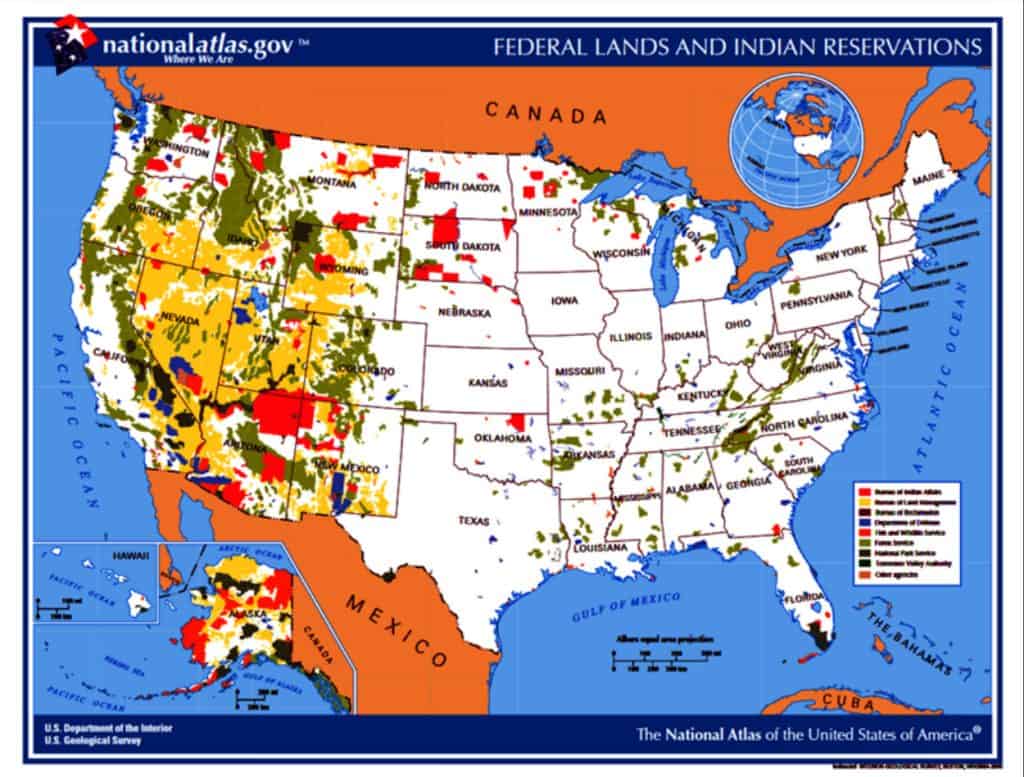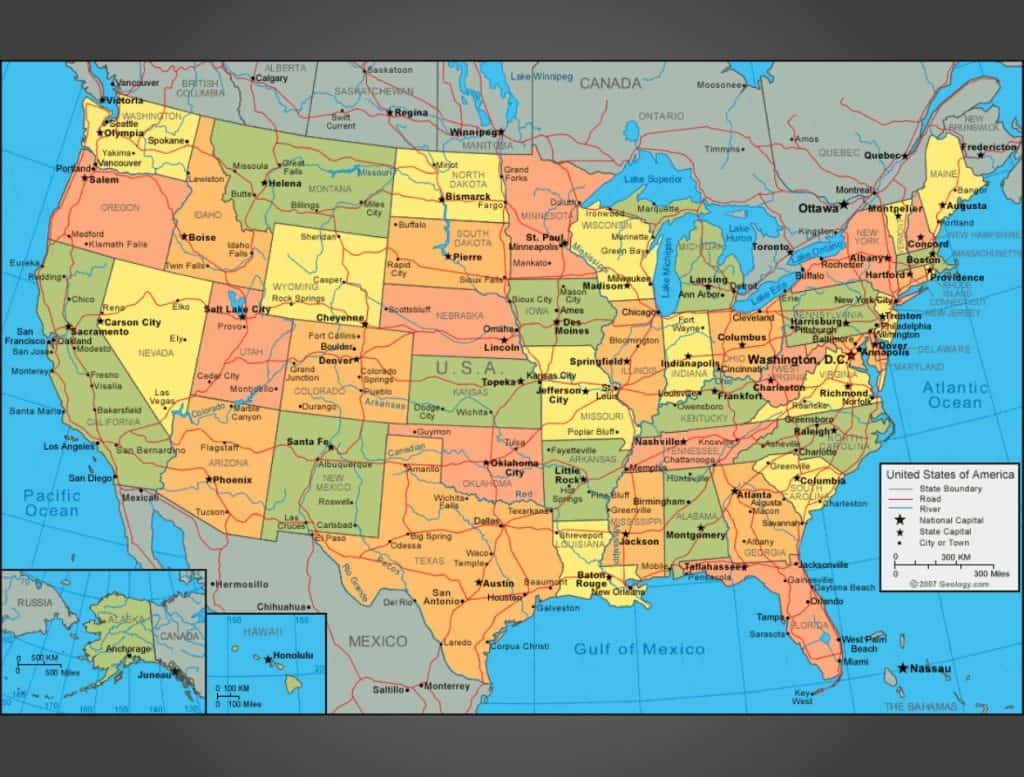Op-Ed By Phillip Davis
As Americans we have enjoyed our national parks for many decades, families have enjoyed these pristine outings daily and some camping as well. But some Americans may have some pause over the amount of land the federal government has acquired over the decades. Worry over what, after all we really enjoy our vacations and outings in our national parks.
The issue of federal land has been written about many times in the past and I believe a reminder is needed from time to time.
I have a question – where does the state of Nevada begin and the federal government’s land end? I’m trying very hard to locate the small pieces of Nevada.
Wait… I think I see it? That sliver of white on the map below, yep, there it is! Good thing, because I thought Nevada was entirely swallowed up by the federal government…whew! Other than Indian lands, the federal government controls 81% of the land in Nevada along with much of the land in Utah, Idaho, Alaska, and Arizona! I’m fairly confident that liberals, or better said, Marxist and progressive types along with ecological purists are happy as a peach most of the land of Nevada, Utah, Idaho, Alaska, and Arizona, are swallowed up by the federal government– “Take more please”. However, the states are supposed to own and maintain political sovereignty over these lands unless it is a military installation or federal structure. So why all the “grabbing”?
Looking at California one would think that state would be entirely swallowed up by the federal government. How California gets off easy on not being mostly staked out as federal land for preservation is a mystery, or is it? After all, it is full of progressives and Marxists and Hollywood actors that just love more and more government intervention. Oh, I get it; “just not here!”
Moving on — Everywhere you see an area of white on the “Federal Lands and Indian Reservations” map it’s fully controlled in that particular state by the federal government, and as for the rest, it’s land owned by Indian tribes.
If you look very closely at the above map (one may need a magnifying glass) you can see Washington D.C. the home of our federal government marked with a black star. I placed a small red ink dot in the middle of that star, that’s about the land area of Washington D.C.
The federal government owns or controls around 30% of the land in the United States, areas such as forests, recreation areas, parks, wildlife refuges, vast tracts of range, and wasteland. Along with that land are military bases, small enclaves, and federal buildings. Article 4 section 3 of the U.S. Constitution reads –
“The Congress shall have power to dispose of and make all needful rules and regulations respecting the territory or other property belonging to the United States; and nothing in this Constitution shall be so construed as to prejudice any claims of the United States, or of any particular state.”
The operative word appears to be needful. So why does the federal government feel the need to gobble up 30% of the area of the United States? Particularly for the past 100 years, there have been many politicians holding office at our federal level in the most powerful positions; they are known as progressives. Progressives are people that believe that they are smarter than most people and also believe when in government, they must control as many people and things as they see fit; they know what is good for you.
Today, Congress is loaded with progressive politicians that just can’t stay out of our business on a personal level and at the state level. Compare this outrageous example for power in Washington D.C. where an area resident is allowed in congress to sit on congressional committees, votes in those committees, and even heads them! While many in the D.C. area push for statehood as the 51st State! (I think I just stepped in something!)
It is past due for the federal government to give back sovereign land to the states and for the people of those states to express their own desires and decisions for their own land use; it is long, long overdue.
Federal land acquisition belonging to the states goes back as far as Abraham Lincoln and the thirst for it seems to never ever end! Oh, that’s right…progressively grabbing!
Abraham Lincoln: However, he changed the course of America’s public lands when he signed a law setting aside the Mariposa Grove and Yosemite Valley as protected lands in 1864.
Ulysses S. Grant: In 1868, Grant set aside the Pribilof Islands in Alaska as a reserve for the northern fur seal. This was the earliest effort to use federally owned land to protect wildlife. In 1872, he signed a law establishing Yellowstone as our nation’s first national park. Today, there are more than 400 sites in the national park system.
Theodore Roosevelt: As president, Roosevelt created five national parks, 18 national monuments, 51 bird sanctuaries, began the National Wildlife Refuge system, and set aside more than 100 million acres for national forests
Woodrow Wilson – In 1916, President Woodrow Wilson signed the “Organic Act,” creating the bureau responsible for protecting America’s 35 already existing national parks and monuments and those yet to be established. Wilson’s administration also presided over the creation of several new national parks, including icons like Dinosaur National Monument and Rocky Mountain National Park.
Franklin Delano Roosevelt – As a lifelong lover of nature and wildlife, President Franklin D. Roosevelt undertook many executive actions to protect and improve public lands. Not only did he create 11 national monuments, his New Deal program — the Civilian Conservation Corps — dramatically impacted existing park lands. Millions of people were put to work building infrastructure in national parks and forests, ultimately planting billions of trees, building roads and trails, and combating soil erosion.
Jimmy Carter – The president from Georgia had a massive impact on public lands in Alaska. When President Jimmy Carter signed the Alaska National Interest Lands Conservation Act of 1980 into law, he set aside over 104 million acres of land, creating 10 national parks and preserves, two national monuments, nine national wildlife refuges, two national conservation areas, and 25 wild and scenic rivers ensuring that large portions of wilderness remain undeveloped.
Barack Obama – In the seven years since President Barack Obama took office, he’s shown his commitment to conservation and preserving America’s special places for future generations. Obama has established 22 national monuments and expanded others to set aside more than 265 million acres of land and water — that’s more than any other president. This includes the expansion of the Pacific Remote Islands Marine National Monument into the largest marine monument in the world and most recently designating three new national monuments in the California Desert.
Visit Tampafp.com for Politics, Tampa Area Local News, Sports, and National Headlines. Support journalism by clicking here to our GiveSendGo or sign up for our free newsletter by clicking here.
Android Users, Click Here To Download The Free Press App And Never Miss A Story. Follow Us On Facebook Here Or Twitter Here.



